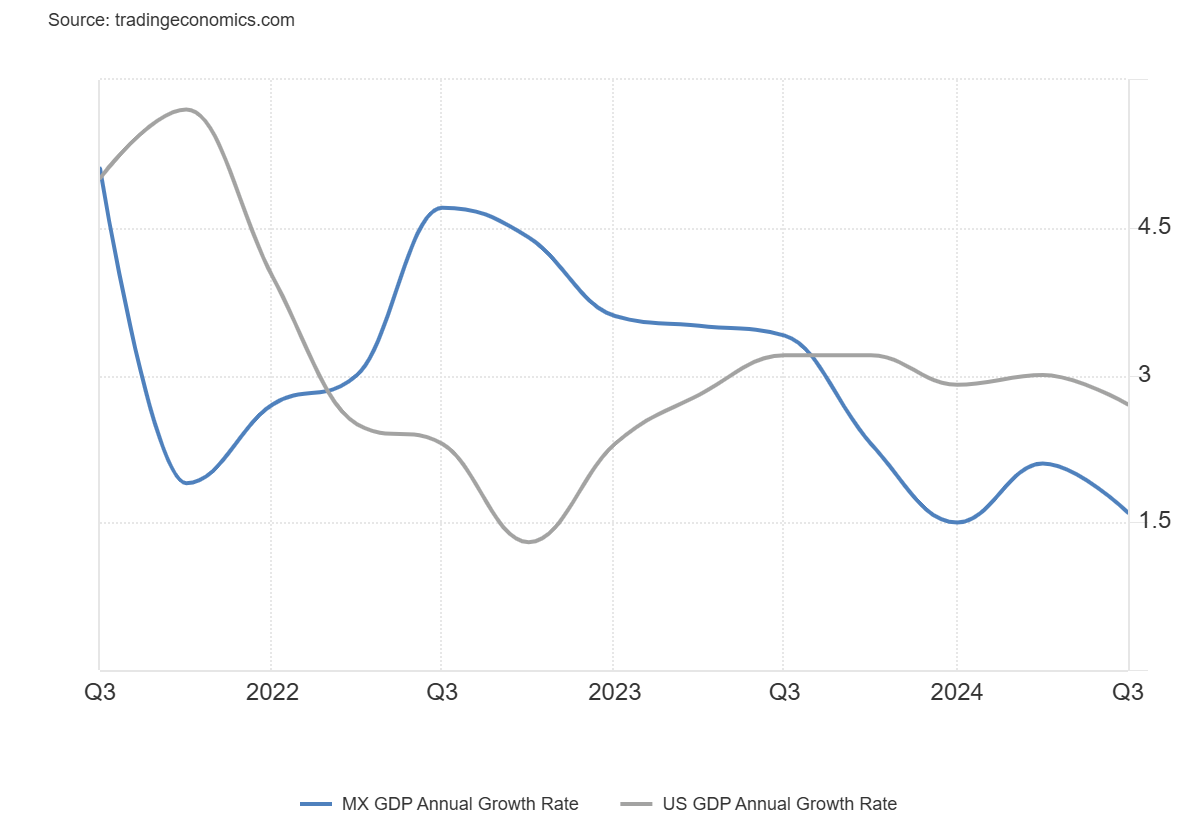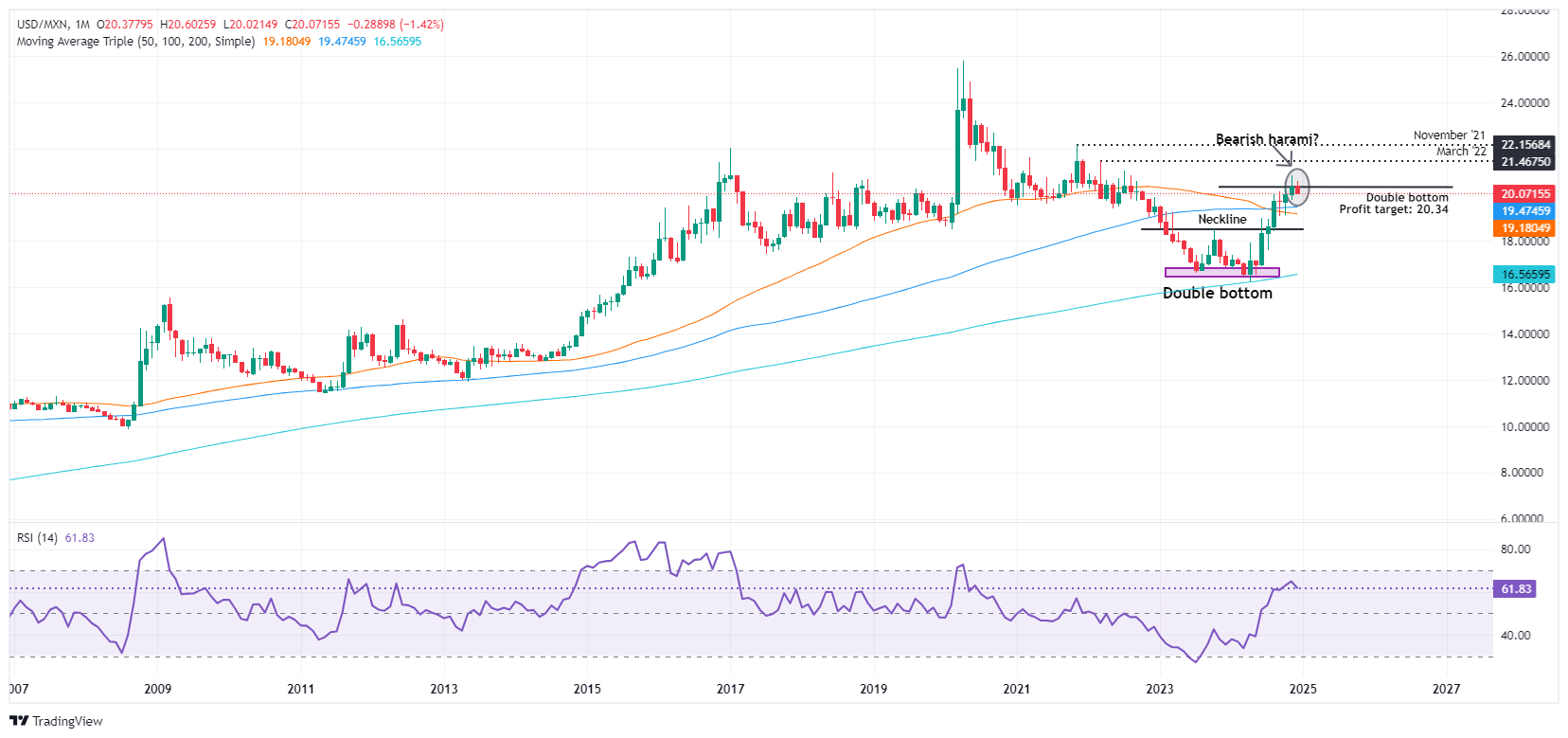- The Mexican Peso is expected to be driven in 2025 by the monetary policy divergence between the Banxico and the Fed.
- The contrast between Mexico’s economic slowdown and dynamism in the US will likely boost the Greenback.
- The USD/MXN pair is set to be underpinned by Donald Trump's trade policies amid the reacceleration of inflation.
The Mexican Peso (MXN) enjoyed a wild ride in 2024 against the US Dollar (USD), initially gaining some steam. However, several factors were headwinds for the Mexican currency, such as general elections in Mexico and the United States (US), the ongoing economic slowdown, monetary policy, geopolitics, and the end of the carry trade. The Peso is foreseen to remain volatile in 2025, beginning with the inauguration of US President-elect Donald Trump and particularly his protectionist policies that, if implemented, could spark a reacceleration of global inflation.
Mexican Peso in 2024: Calm before the storm
The Mexican Peso began the first quarter of 2024 on the front foot, appreciating modestly due to the so-called carry trade. The interest rate differential between Mexico and the US, of more than 575 basis points (bps), benefitted the former. However, Banco de Mexico (Banxico) began its easing cycle on March 21 by reducing rates by 25 bps.
Although Banxico’s decision was expected to weaken the Peso as it shrank the interest rate differential, it didn’t. However, tensions in the Middle East were about to rise, spurring the first spike in the exchange rate.
Banxico Interbank Lending Rate. Source: FXStreet
Mexican Peso depreciates sharply as Middle East conflict escalated
On April 9, the USD/MXN was trading at around eight-year lows of 16.25, but Iran and Israel exchanged attacks between April 13 and 19, sparking a flight to safe-haven assets.
Consequently, the Greenback rose to the detriment of the Mexican Peso as news headlines crossed the wires, with the USD/MXN soaring from around multi-year lows to 18.15 on April 19. In a seven-day span, the Mexican currency depreciated by over 10%.
Banxico cuts again, politics take center stage
The second quarter featured Banxico’s second interest rate cut on May 9 in a 3-2 split vote, with Deputy Governors Heath and Espinosa dissenting to cut rates.
In June, President Claudia Sheinbaum Pardo of the ruling party Morena became the first female President. Once the results were known, the USD/MXN traded volatile, with the Peso depreciating over 4% on June 3 amid fears that Morena and its coalition would secure the majority in Congress and change the Constitution.
Investors ditch MXN as Congress approves reforms, Fed turns dovish
The third quarter was challenging for the Mexican currency, which began to be sold after former President Andres Manuel Lopez Obrador presented bills for the upcoming Congress. One proposal was to reform the judicial system, and the second was to dissolve autonomous bodies created to level the playing field between the government and private companies.
Since the judicial reform was approved in September, the Mexican Peso extended its landslide, as the USD/MXN rose from around 18.99 to 20.22, hitting a yearly high back then.
In the US, Federal Reserve Chairman Jerome Powell said in Jackson Hole that it was time to begin lowering interest rates as the risk of inflation was tilted to the downside. At that time, the US labor market seemed to weaken further, with risks of the unemployment rate skewed to the upside.
Fed Funds Rate. Source: FXStreet
US Unemployment Rate. Source: FXStreet
Sheinbaum takes office, Trump wins US election, and Fed eases policy
As the year agonized, the Mexican Peso lost steam after Claudia Sheinbaum began her six-year term in October and Donald Trump won the US general election.
US President-elect Trump began his harsh rhetoric against Mexico, threatening to impose tariffs on Mexican imports to the US if the country didn’t agree to fight drug cartels and stop illegal immigration.
"One [US] tariff will be followed by another [from Mexico], and so on until we put common enterprises at risk," Sheinbaum said in response to Trump. "The main victims will be US consumers who buy manufactured cars from Mexico," she added.
On the monetary policy front, the Federal Reserve cut rates by 100 basis points in the second half of 2024, leaving the fed funds rate at the 4.25%-4.50% range. Meanwhile, Banxico slashed borrowing costs by an additional 75 bps of cuts, which added to the already 50 bps cut earlier, leaving the main interbank lending rate at 10.00%.
What’s next for the Mexican Peso in 2025?
The Peso will be influenced by economic growth, monetary policy, inflation, and – you’ve guessed it – US President-elect Donald Trump. If Mexican President Claudia Sheinbaum reaches agreements with Trump’s agenda, that could remove one factor and leave market players focused on purely economic themes.
Divergence in economic growth: Mexico to grow less than US
Mexico’s economy is expected to underperform compared to the past two years. However, the services sector continues to outperform manufacturing, supported by subsequent government increases in minimum wages. Overall, growth is expected to be sluggish due to the Government's fiscal consolidation plan, which was considered in the 2025 budget, and Banxico's still-high interest rates.
Banxico private economists' survey showed that analysts estimate the economy will grow 1.17% in 2025, below the 1.55% seen in 2024.
In the US, the Summary of Economic Projections (SEP) showed that Fed policymakers estimate the US economy will grow 2.1% in 2025, up from the 2% previously expected.
GDP comparison between US and Mexico. Source: Trading Economics.
Inflationary pressures build in the US, not so in Mexico
Mexico’s disinflation process has evolved substantially during the year. November’s core Consumer Price Index (CPI) dropped three tenths to 3.58%. Even though it remains above Banxico’s target, the central bank remains confident it will reach the 3% goal by the last quarter of 2025 or early 2026, as revealed in December’s meeting monetary policy statement.
In the US, the story is different. Inflation has reaccelerated during the last five months. The core Personal Consumption Expenditures (PCE) Price Index – The Fed’s preferred inflation gauge – hit its yearly bottom of 2.6% in June 2024. Inflation had risen to 2.8% in November, indicating that monetary policy wasn't as restrictive as many Fed officials thought.
Alongside that, the upcoming White House administration's threats of imposing tariffs, deregulation, and tax cuts could deteriorate the US inflationary scenario.
US core PCE. Source: FXStreet
Will the Fed pause as Banxico extends its easing cycle?
Monetary policy in the US and Mexico is expected to diverge in 2025. Banxico is expected to continue its loosening cycle, with estimates that the primary reference rate would be lowered from 10.00% to 8.00%, according to Banxico’s private survey. This implies a reduction of 0.25% in each of the eight monetary policy meetings.
Additionally, the Mexican institution opened the door to large-scale rate cuts after tweaking its policy statement. “In view of the progress on disinflation, larger downward adjustments could be considered in some meetings, albeit maintaining a restrictive stance,” it said.
Meanwhile, Federal Reserve officials have adopted a more cautious stance as data suggested that the economy “is in a very good place,” according to Fed Chair Jerome Powell. Even though the board agrees that easing policy is needed, they also acknowledged the pace should be reduced.
The Fed’s December projections suggested that policymakers consider 50 bps of easing, down from the 100 bps foreseen in September.
Overall, the interest rate differential between Mexico and the US could be reduced from 550 bps to 400 bps in the upcoming year. Therefore, further USD/MXN upside is possible.
Trump’s tariffs, lower taxes set to underpin USD/MXN
The Mexican Peso is already facing the challenges of a Donald Trump presidency even though he won't take office until January 20. His victory keeps the financial markets on their toes as some of his policies tend to be protectionist and focused on domestic issues.
Trump has threatened to impose tariffs, even saying it's his favorite word. So far, he signaled that he will impose tariffs on imports from Mexico if the country fails to improve fighting drug cartels and stop illegal immigration.
This could lead to Mexico’s retaliatory actions. Nevertheless, Trump believes that imposing tariffs would benefit the US, although most trading partners warned that the costs would be passed on to customers.
If Congress approves tariffs – or through Presidential Executive Orders – these could exert upward inflation pressures and trigger another round of higher prices, preventing the Fed from easing policy.
USD/MXN Technical Analysis: Awaiting catalysts
The USD/MXN is upward-biased, as the monthly chart depicts, yet it shows signs of consolidation as buyers lose steam after reaching a "double bottom" profit target objective at 20.34. The exotic pair cleared the latter and hit a year-to-date (YTD) high of 20.83 before retreating to the current levels.
Suppose the pair finishes the year confined within the 19.76-20.83 range. In that case, that will confirm the formation of a "bearish harami" candle chart pattern, which opens the door for further downside.
The Relative Strength Index (RSI) shows buyers are losing steam, indicating that consolidation lies ahead.
In that outcome, sellers would have the upper hand. The USD/MXN first support is seen at the 100-month Simple Moving Average (SMA) of 19.47. A breach of the latter will expose the 50-month SMA at 19.18, followed by the psychological 19.00 figure. On further weakness, bears could drive the exchange rate toward the previous "double bottom" neckline at 18.50.
On the other hand, if buyers hold USD/MXN above 20.00 and push the exchange rate above 20.50, this could open the door for gains. The first resistance would be the 2024 peak at 20.83, followed by the 21.00 mark. Once cleared, key resistance levels emerge at the March 2022 peak at 21.46, followed by the 22.00 figure ahead of the November 2021 high at 22.15.
Conclusion
The Mexican Peso faces a confluence of challenges heading into 2025, ranging from domestic political shifts to international geopolitical dramas.
The currency's trajectory will likely be heavily influenced by the interplay between Mexico's monetary policy and its economic growth relative to the US. This would usually favor further USD/MXN upside, as the interest rate differential would reduce.
Additionally, the Greenback would strengthen if the incoming US administration under Donald Trump introduced fiscal expansionary policies and imposed tariffs, as they are inflationary prone. On the other hand, geopolitical risks looming in the Middle East and the Russia-Ukraine conflict loom, favoring a flight to safe-haven assets, implying USD upside and MXN downside.
Mexican Peso FAQs
The Mexican Peso (MXN) is the most traded currency among its Latin American peers. Its value is broadly determined by the performance of the Mexican economy, the country’s central bank’s policy, the amount of foreign investment in the country and even the levels of remittances sent by Mexicans who live abroad, particularly in the United States. Geopolitical trends can also move MXN: for example, the process of nearshoring – or the decision by some firms to relocate manufacturing capacity and supply chains closer to their home countries – is also seen as a catalyst for the Mexican currency as the country is considered a key manufacturing hub in the American continent. Another catalyst for MXN is Oil prices as Mexico is a key exporter of the commodity.
The main objective of Mexico’s central bank, also known as Banxico, is to maintain inflation at low and stable levels (at or close to its target of 3%, the midpoint in a tolerance band of between 2% and 4%). To this end, the bank sets an appropriate level of interest rates. When inflation is too high, Banxico will attempt to tame it by raising interest rates, making it more expensive for households and businesses to borrow money, thus cooling demand and the overall economy. Higher interest rates are generally positive for the Mexican Peso (MXN) as they lead to higher yields, making the country a more attractive place for investors. On the contrary, lower interest rates tend to weaken MXN.
Macroeconomic data releases are key to assess the state of the economy and can have an impact on the Mexican Peso (MXN) valuation. A strong Mexican economy, based on high economic growth, low unemployment and high confidence is good for MXN. Not only does it attract more foreign investment but it may encourage the Bank of Mexico (Banxico) to increase interest rates, particularly if this strength comes together with elevated inflation. However, if economic data is weak, MXN is likely to depreciate.
As an emerging-market currency, the Mexican Peso (MXN) tends to strive during risk-on periods, or when investors perceive that broader market risks are low and thus are eager to engage with investments that carry a higher risk. Conversely, MXN tends to weaken at times of market turbulence or economic uncertainty as investors tend to sell higher-risk assets and flee to the more-stable safe havens.
Information on these pages contains forward-looking statements that involve risks and uncertainties. Markets and instruments profiled on this page are for informational purposes only and should not in any way come across as a recommendation to buy or sell in these assets. You should do your own thorough research before making any investment decisions. FXStreet does not in any way guarantee that this information is free from mistakes, errors, or material misstatements. It also does not guarantee that this information is of a timely nature. Investing in Open Markets involves a great deal of risk, including the loss of all or a portion of your investment, as well as emotional distress. All risks, losses and costs associated with investing, including total loss of principal, are your responsibility. The views and opinions expressed in this article are those of the authors and do not necessarily reflect the official policy or position of FXStreet nor its advertisers. The author will not be held responsible for information that is found at the end of links posted on this page.
If not otherwise explicitly mentioned in the body of the article, at the time of writing, the author has no position in any stock mentioned in this article and no business relationship with any company mentioned. The author has not received compensation for writing this article, other than from FXStreet.
FXStreet and the author do not provide personalized recommendations. The author makes no representations as to the accuracy, completeness, or suitability of this information. FXStreet and the author will not be liable for any errors, omissions or any losses, injuries or damages arising from this information and its display or use. Errors and omissions excepted.
The author and FXStreet are not registered investment advisors and nothing in this article is intended to be investment advice.
Recommended Content
Editors’ Picks

AUD/USD strengthens as Trump confirms talks with China
The Australian Dollar extends its rally, with the AUD/USD gaining ground as the US Dollar weakens amid growing concerns over the economic impact of tariffs on the United States. Market participants are closely monitoring developments in US trade negotiations, although trading activity is expected to be subdued due to the Good Friday holiday.

USD/JPY weakens below 142.50 as Japanese CPI came in at 3.6% YoY in March
The USD/JPY pair softens to near 142.25 in a thin trading volume session on Friday. The US Dollar edges lower against the Japanese Yen amid concerns over the economic impact of tariffs.

Gold price loses momentum on profit-taking
Gold price holds steady on Friday after retreating from an all-time high of $3,358 as investors book profits during a long Easter weekend. Significant uncertainty over US President Donald Trump's tariffs on imports into the US and ongoing geopolitical tensions could underpin the Gold price.

Ethereum ETFs total net assets plummet over 60%; Justin Sun says he won't sell ETH
Ethereum traded just below $1,600 on Thursday following a 60% plunge in the total net assets of US spot Ether ETFs. Meanwhile, Tron founder Justin Sun said that he won't sell his ETH holdings despite the sustained downtrend in the top altcoin’s price.

Future-proofing portfolios: A playbook for tariff and recession risks
It does seem like we will be talking tariffs for a while. And if tariffs stay — in some shape or form — even after negotiations, we’ll likely be talking about recession too. Higher input costs, persistent inflation, and tighter monetary policy are already weighing on global growth.

The Best brokers to trade EUR/USD
SPONSORED Discover the top brokers for trading EUR/USD in 2025. Our list features brokers with competitive spreads, fast execution, and powerful platforms. Whether you're a beginner or an expert, find the right partner to navigate the dynamic Forex market.





